In the middle of the chaotic Premier League holiday schedule, Liverpool met Wolverhampton Wanderers in a tensely-played match. The Reds had recently demolished second-place Leicester City in one of the most anticipated matchups of the season, extending their lead on the table. Wolves had also just accomplished an impressive victory in a 3-2 win against Manchester City. This tactical analysis examines the strategies of both sides along with the devices used by Jürgen Klopp and Liverpool to continue their near-unprecedented winning streak.
Lineups
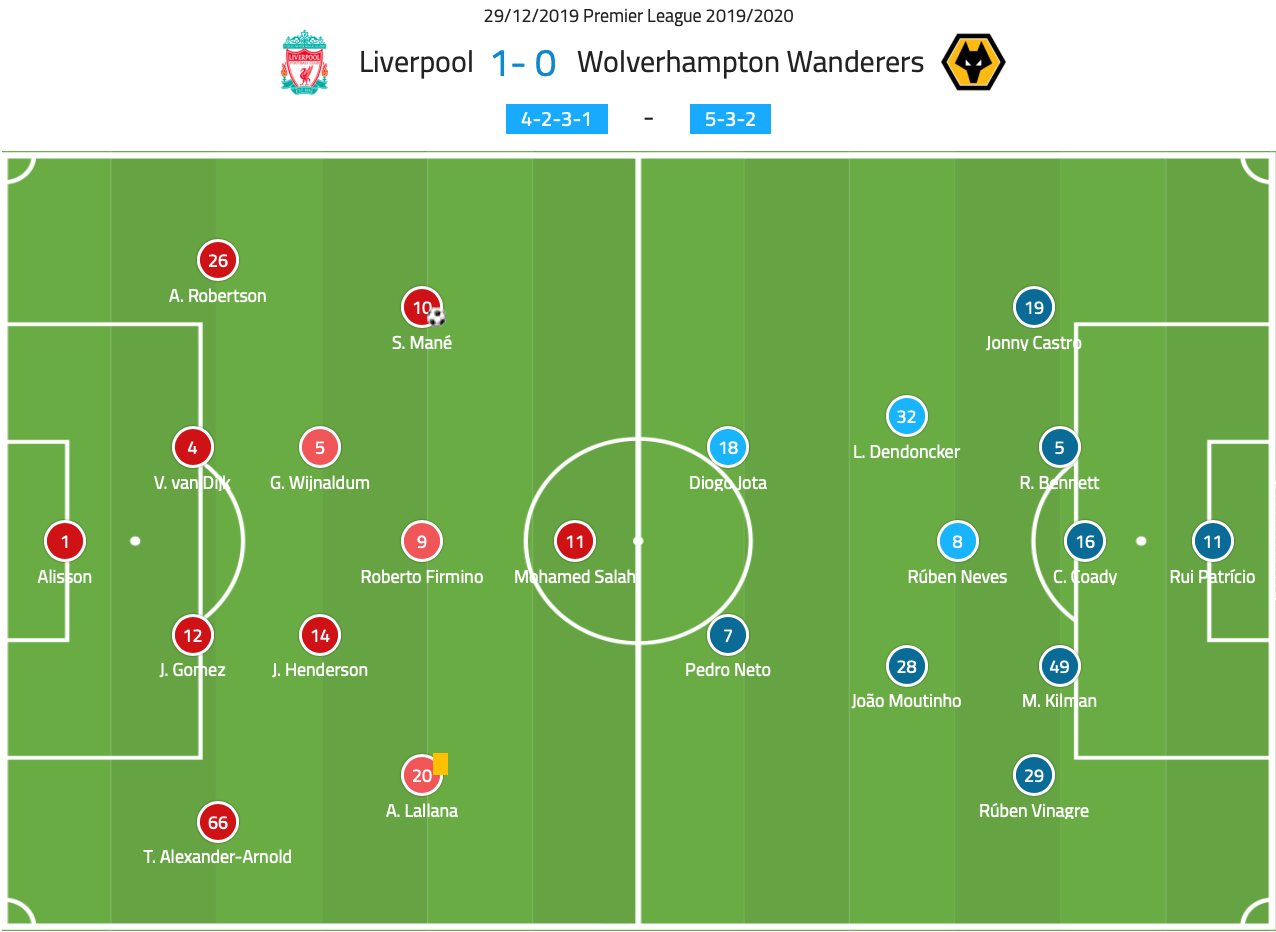
The Premier League leaders came out in a general 4-2-3-1 shape, something they have rarely done this season. This was at times adjusted to a 4-4-2/4-4-1-1 shape, especially later in the match when Liverpool had the lead or were out of possession. Joe Gomez started his second consecutive match alongside Virgil van Dijk despite coming off the bench for a majority of the season. Trent Alexander-Arnold and Andrew Robertson completed the back line as the full-backs. Jordan Henderson and Georginio Wijnaldum started as the two deeper midfielders behind the attack of Adam Lallana, Roberto Firmino, Sadio Mané, and Mohamed Salah. Salah led the line as the central striker, something he has become more accustomed to this season.
Wolves manager Nuno Espírito Santo left the top two league goalscorers for the Wolves- Raúl Jiménez and Adama Traoré- on the bench after they both started and scored in the Manchester City match two days before. In their common back five/back three formation, Ryan Bennett, Conor Coady, and Max Kilman began as the three centre-backs. Jonny Castro and Rúben Vinagre started as the wing-backs, with a central midfield made up of Leander Dendoncker, Rúben Neves, and João Moutinho. Pedro Neto and Diogo Jota led the front line, but both would ultimately struggle to attack with Wolves’ limited shot opportunities.
Liverpool control early
Liverpool controlled the match from the start. In possession, the hosts comfortably rotated the ball along the back lines. With the lack of pressure from the opposition, opening up space in the middle of the pitch wasn’t difficult.
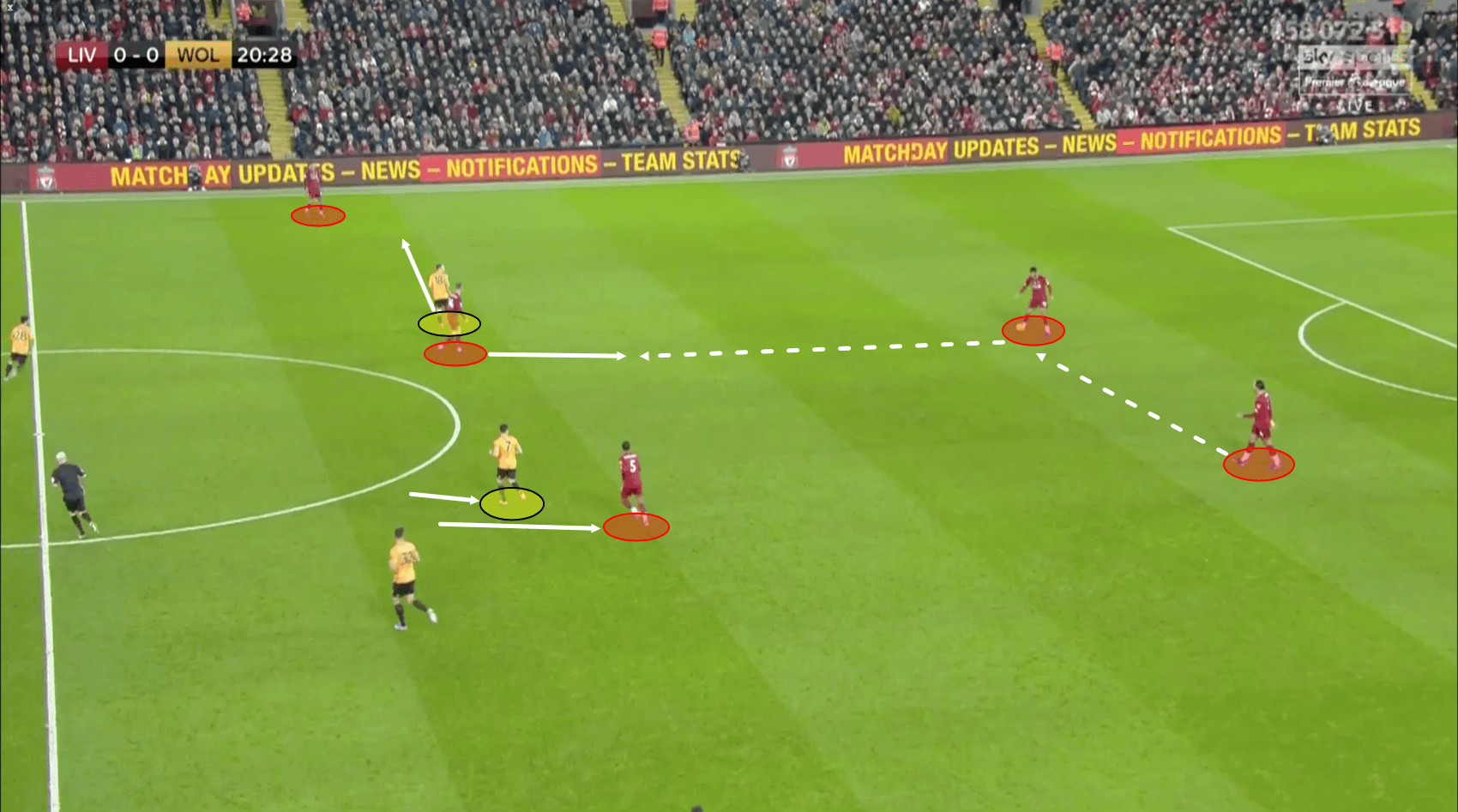
Here, Van Dijk rotates the ball to Gomez. In a possession formation with a deeper midfield two, there was an increase in typical passing outlets, as instead of simply having a centre defensive midfielder or a full-back, the centre-back had an additional midfielder to progress possession to. Henderson and Wijnaldum regularly dropped back to receive forward passes. This specific case sees Henderson drop to receive Gomez’s pass, with his marking defender, Jota, opting to block off the wide passing lane to Alexander-Arnold. This Wolves defensive tactic will come up later in this analysis.
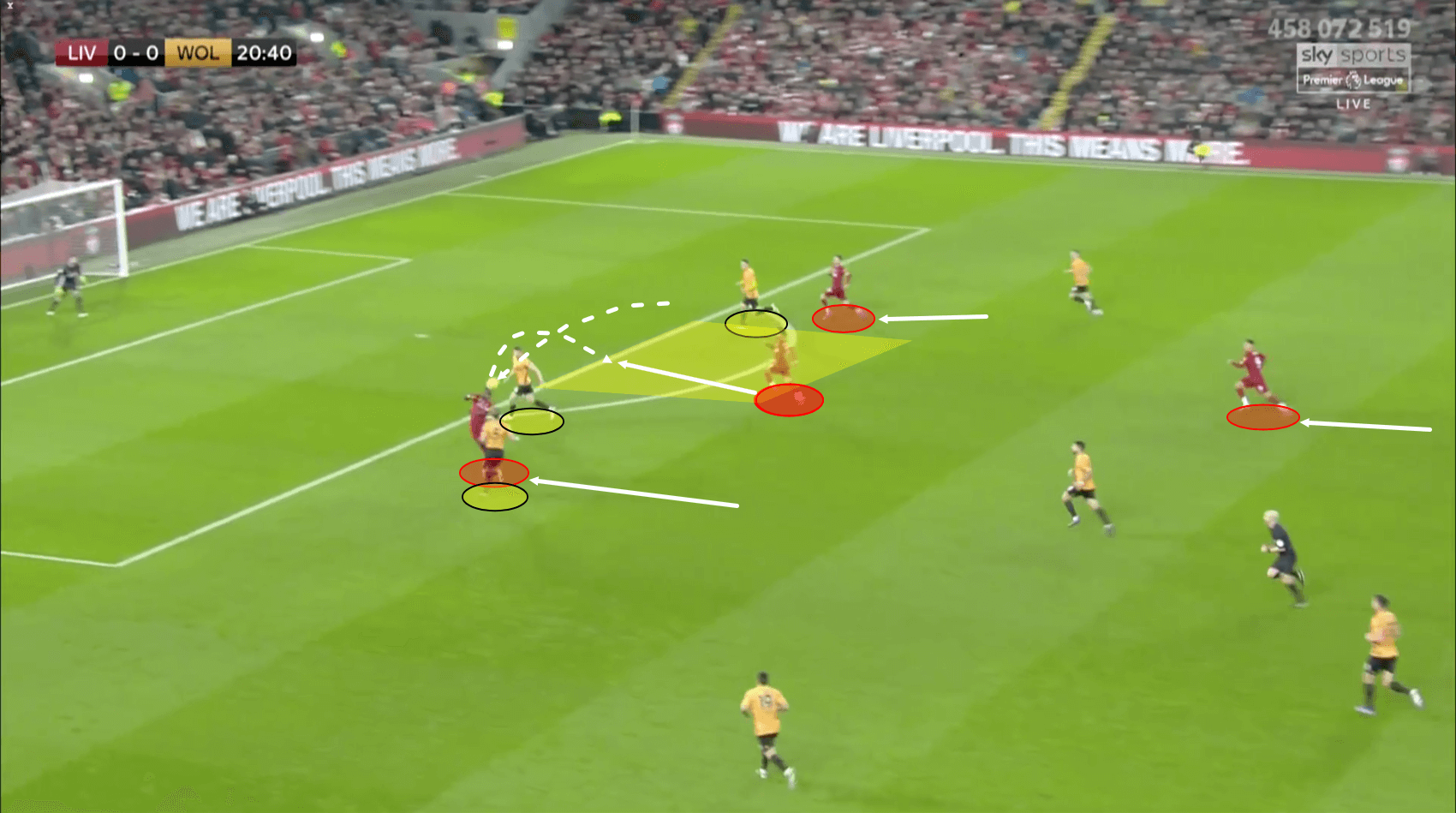
With this ample amount of time on the ball, Liverpool were able to consistently launch long passes towards the forwards in attempts to initiate quick attacks. After Henderson receives the ball in the first frame, van Dijk pushes forward and receives a pass from Henderson. He then launches this long ball, which reaches the head of Mané. The Senegalese winger is able to head the ball down into the dangerous area of zone 14. With the two wide centre-backs marking the wide attackers Lallana and Mané, and the middle centre-back moving to block Mané’s path to goal, Salah is left open in this area and executes a shot on target.
Already the formation change in possession proved to be a brilliant move by Klopp. Both the additional passing option at the back and additional attacker at the front became advantageous in chance creation, as 70% of Liverpool’s possessions reached the opposing half and the team averaged nearly one attack(a possession that includes at least one action in the opposing final third) every two minutes.
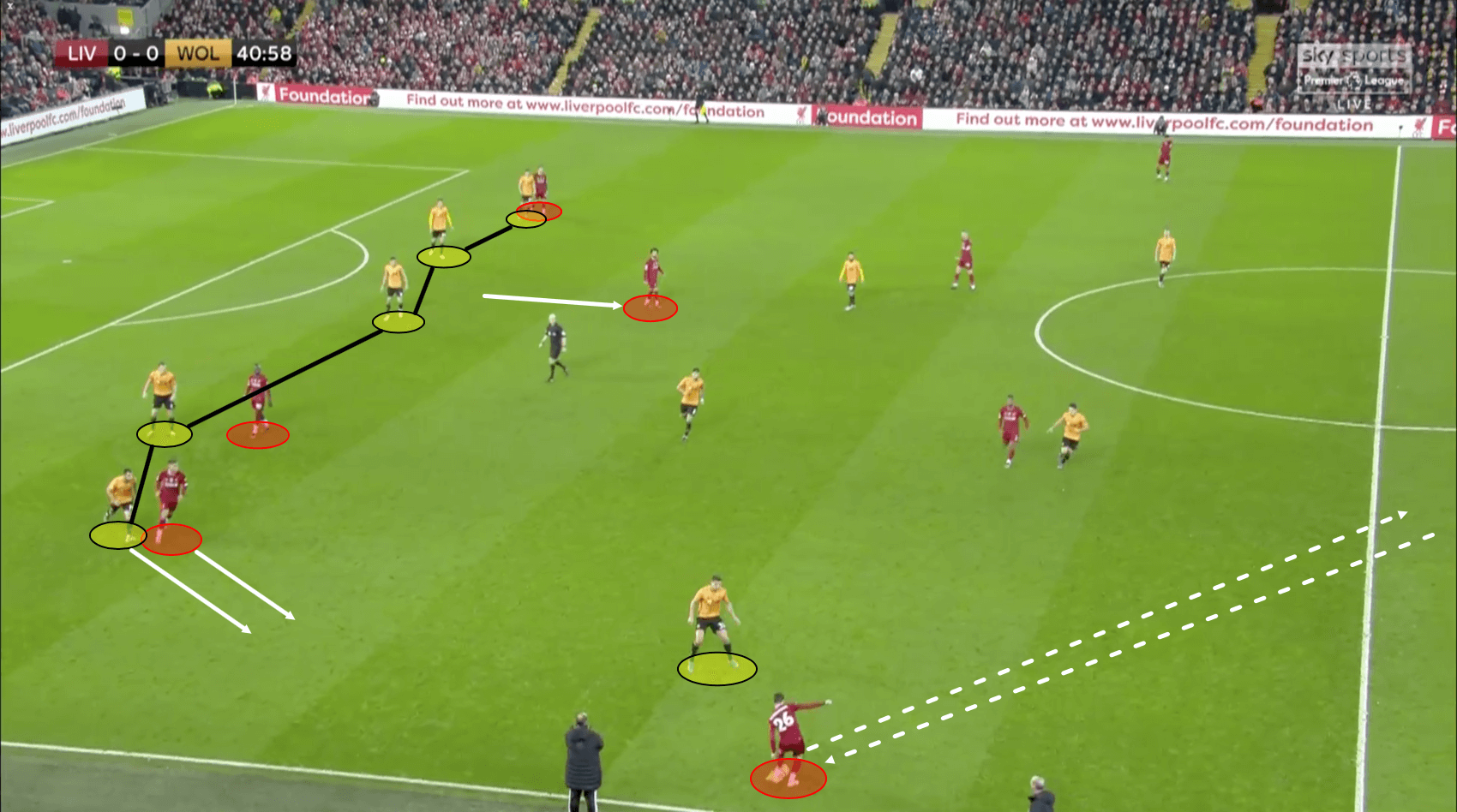
This level of possession eventually resulted in what would be the match-winning goal. Nuno’s defensive intent for his side was to block off the wide areas and force buildup centrally. Yet Liverpool still were able to use this to their advantage. Here, Robertson receives a pass from Van Dijk, but with pressure coming from Dendoncker, he immediately passed back to the Dutchman. In this process, however, Firmino pulled out the right wing-back Castro by offering himself as a wide passing outlet to Robertson.
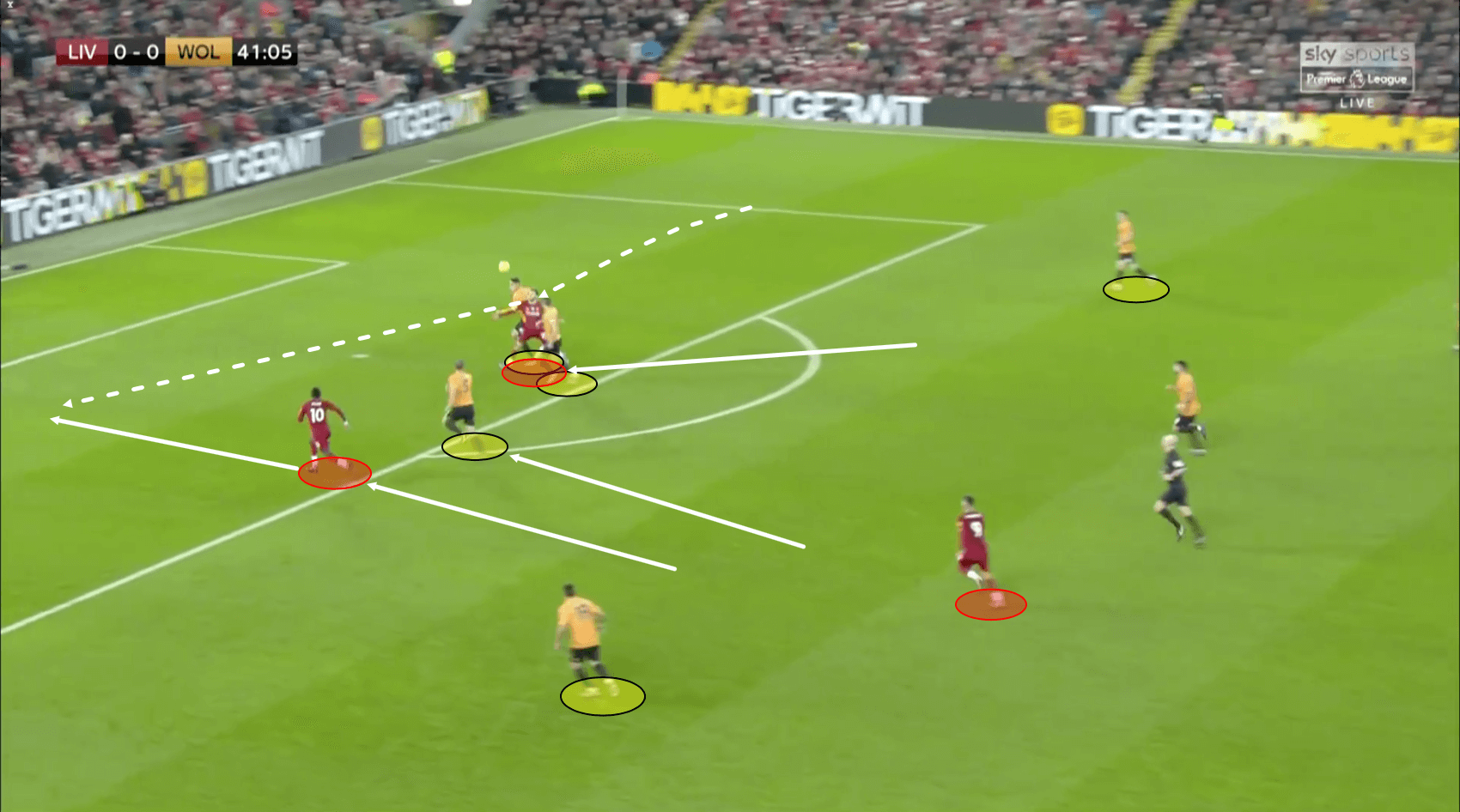
Van Dijk saw this and again hit an aggressive long ball into the final third. With Castro pulled forward, Firmino’s drop into midfield and Lallana’s run isolated the full-backs. The two ball-near centre-backs pressured Lallana, which meant Mané was in a 1v1 with the right centre-back Bennett. He was able to pass him with pace, and Lallana was physical enough to muscle off the other two centre-backs and deflect the ball into Mané’s path for a goal.
Wolves defensive tactics
The primary reason Liverpool didn’t have the lead earlier in the match was the defensive organisation of Wolves. Wolves under Nuno have earned a reputation as a defensively stout team, and this match was no different.
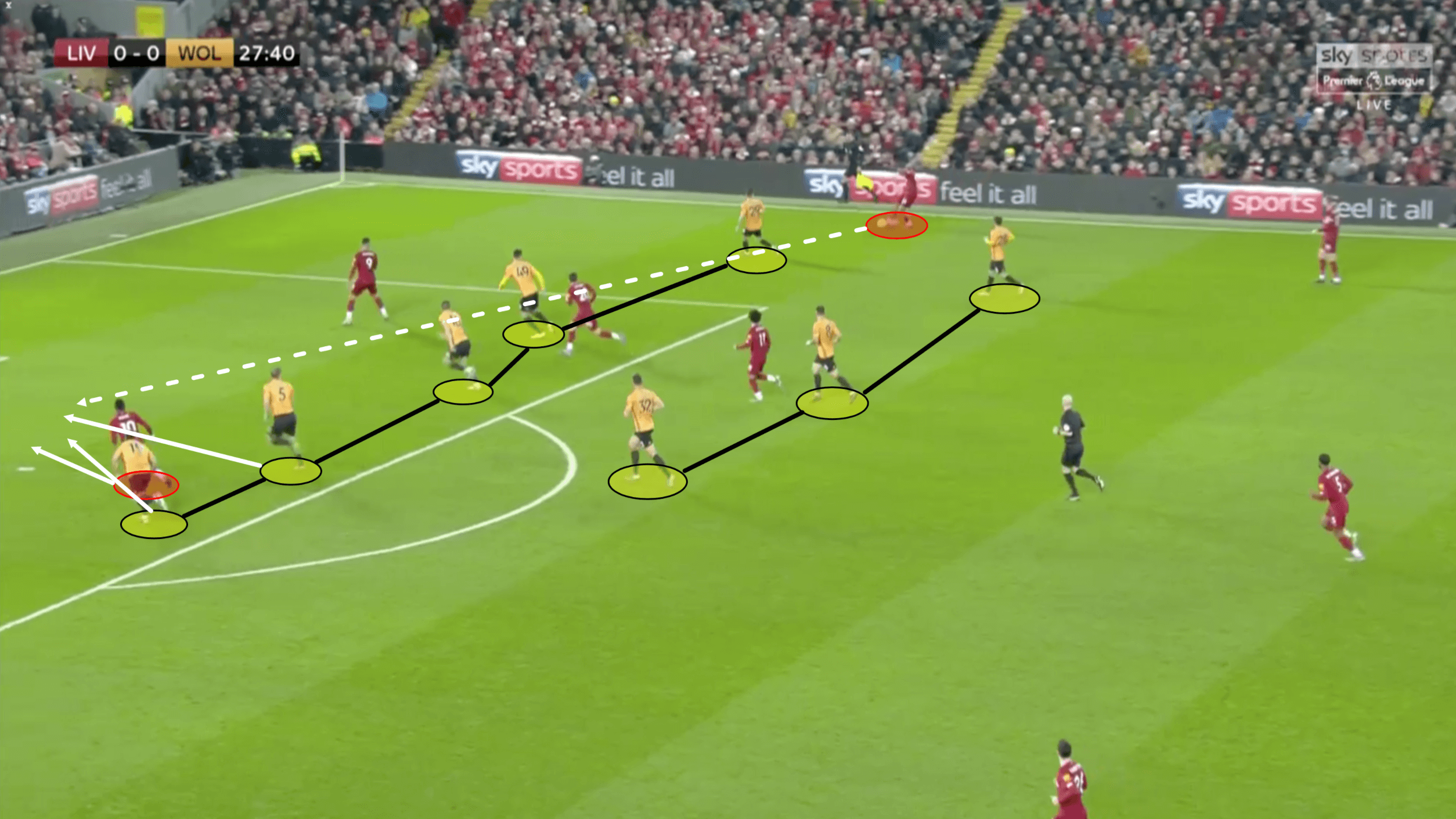
In this example, Alexander-Arnold managed to carry the ball forward into the wide areas, which wasn’t common for Liverpool’s full-backs. Nevertheless, the cross to Mané was quickly smothered by the defenders on the far side of the back line. This led to a clearance and Liverpool resetting their possession.
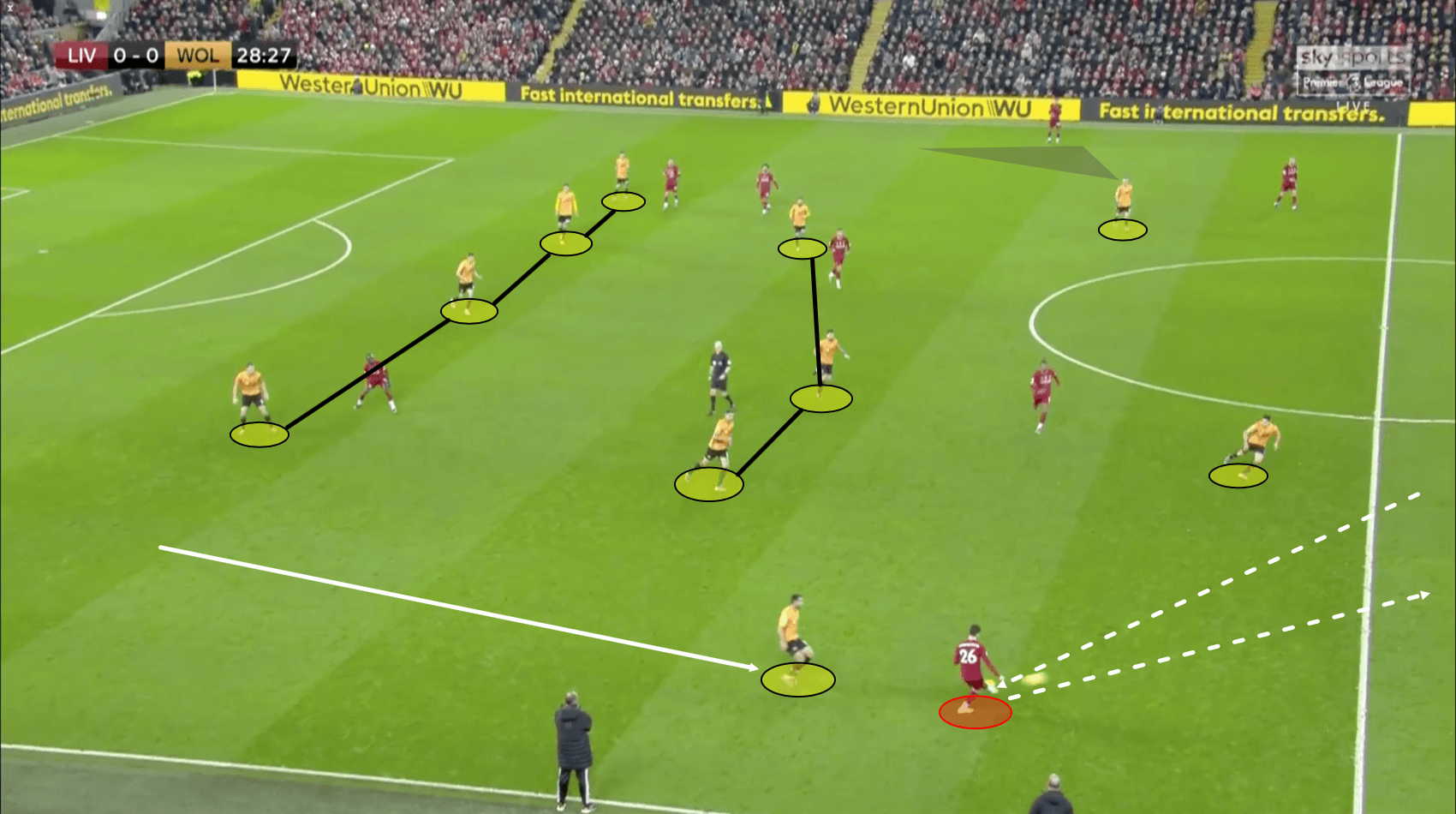
As stated, Nuno emphasised nullifying the opposing full-backs in attack. After the reset, Liverpool’s back lines rotated ball possession and attempted buildup through the opposite full-back, Robertson. Here however Castro pressed the Scotsman, forcing an immediate backpass and possession to reset again. While this was the tactic Liverpool took advantage of on their goal, the centre-backs for Wolves were more often able to cover the advanced wide spaces.
The frequency of Wolves’ maintained rigidity sacrificed pressure, as seen in the graph below, but this was simply the tactics Nuno utilised.
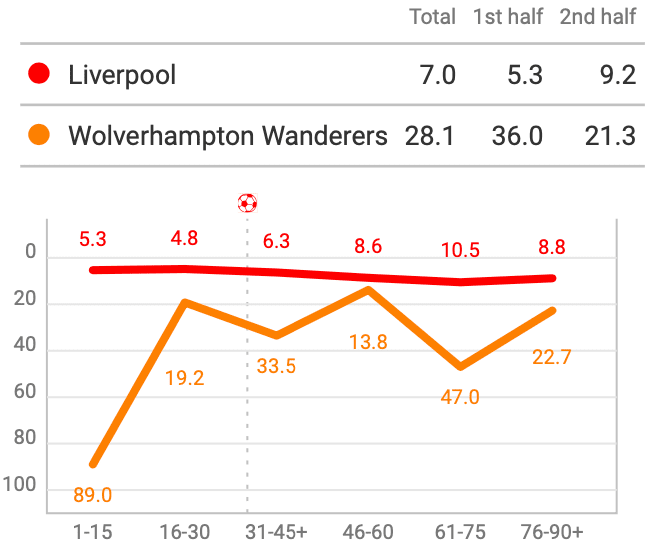
This graph represents the passes allowed per defensive action of Liverpool and Wolves. The visitors clearly allowed abundant possession in order to preserve their deep defensive structure.
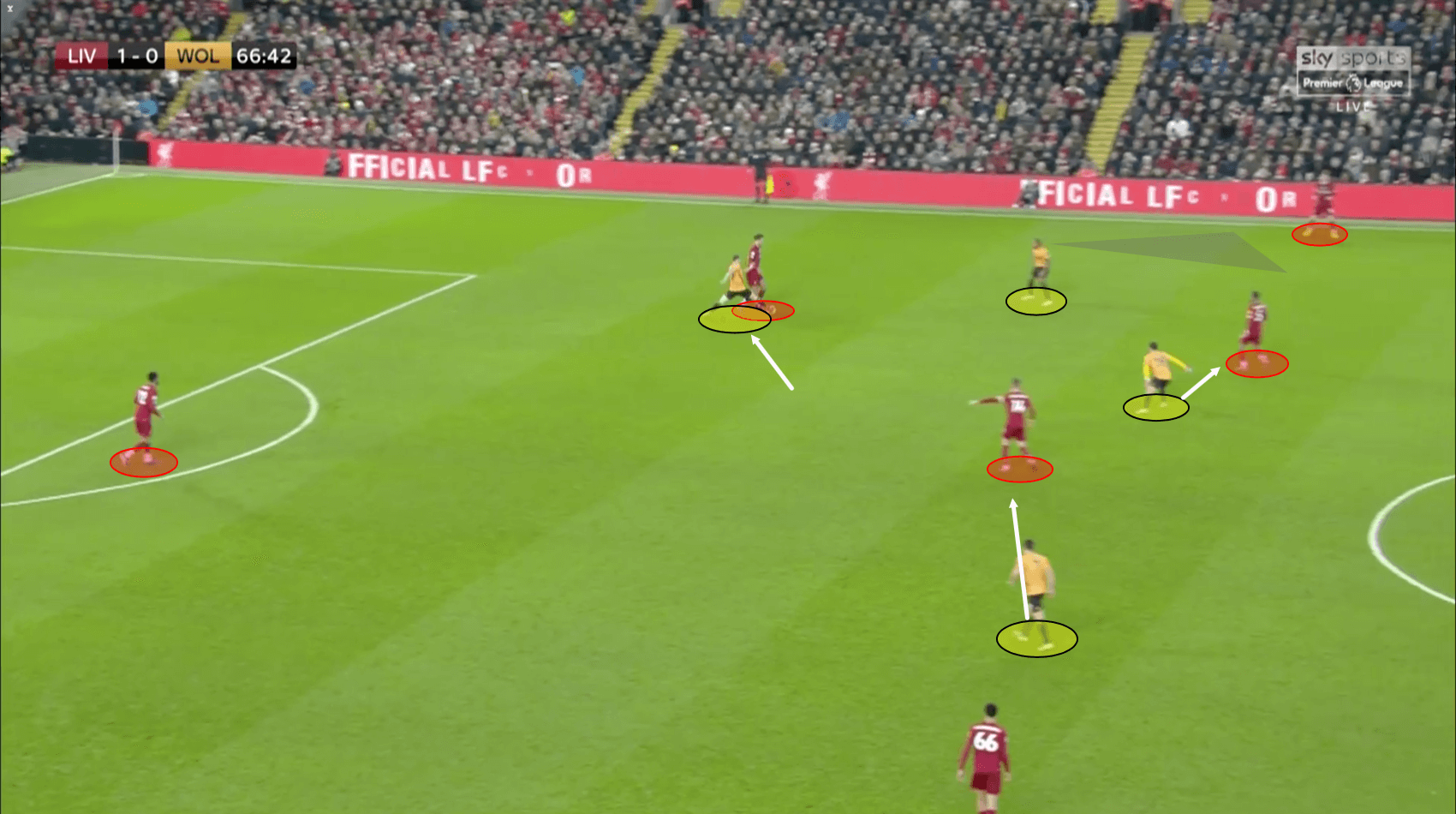
Eventually, Nuno adjusted his defensive tactics, subbing on Traoré and later Jiménez and increasing pressure on Liverpool’s back line. While it wasn’t the most effective press, it was still aggressive enough to disrupt Liverpool’s possession flow and create quicker attacks. This instance above shows Jota pressing the ball off Van Dijk while Traoré uses a cover shadow on Robertson and other Wolves attackers press other passing outlets.
Liverpool adjustments
Klopp, in turn, made his own tactical adjustments. With the lead, Liverpool naturally held less possession in the second half than the first. Out of possession, they shifted into a 4-4-2 defensive block. This move prevented the Wolves’ increased time on the ball from creating many quality opportunities.
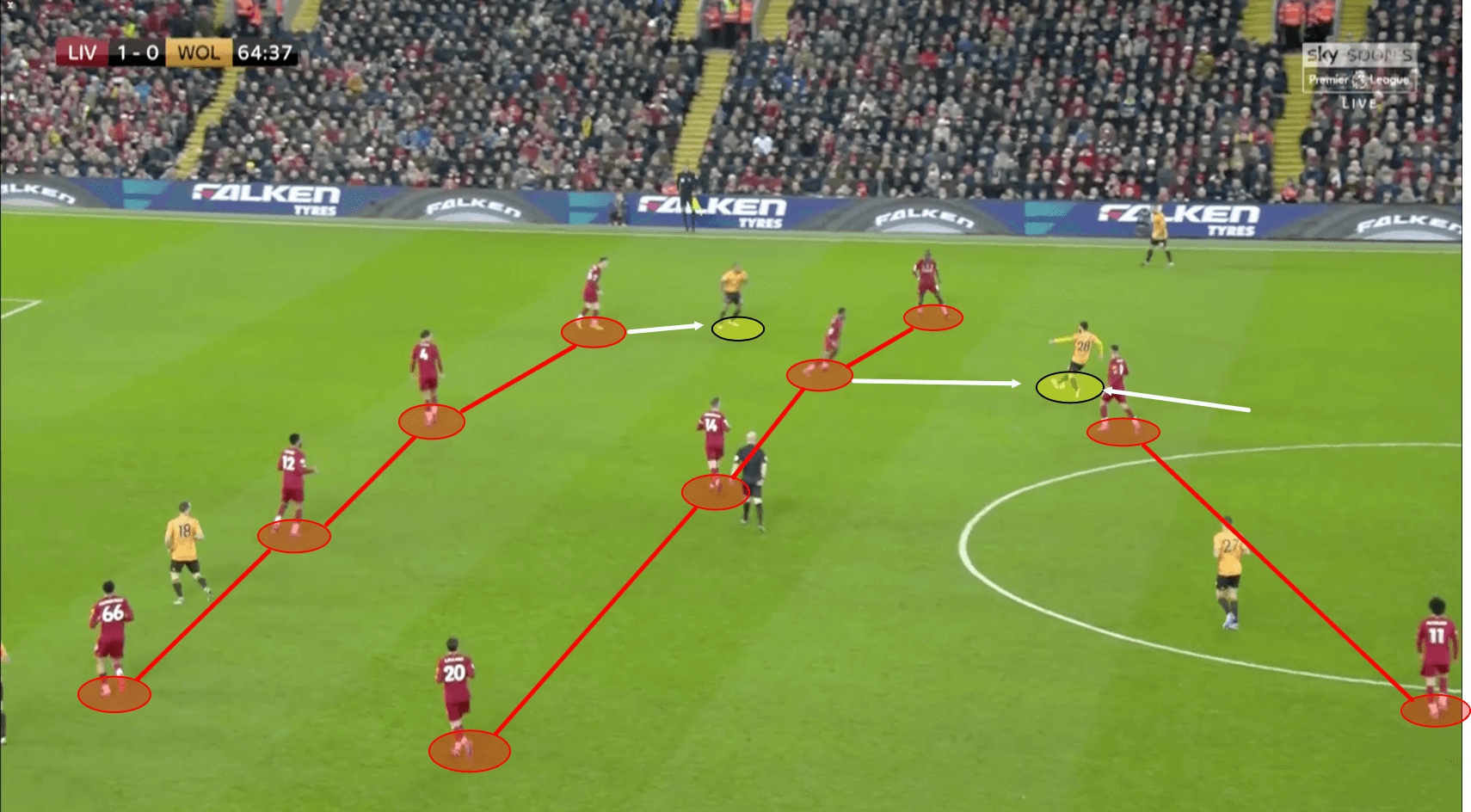
In the image above, Liverpool are sitting in their defensive 4-4-2 formation. Wijnaldum presses the ball which forces a pass wide, and with both the passing options of Traoré and Moutinho covered by Robertson and Wijnaldum respectively, Castro is forced into a backpass.
While the German manager hasn’t been known for his substitution decisions, Klopp correctly subbed off Lallana in the 67’ for Naby Keïta. Keïta’s fresh legs and deeper positioning helped keep Wolves attackers from reaching dangerous areas. Even in the wide areas, Wolves found limited attacking opportunities.
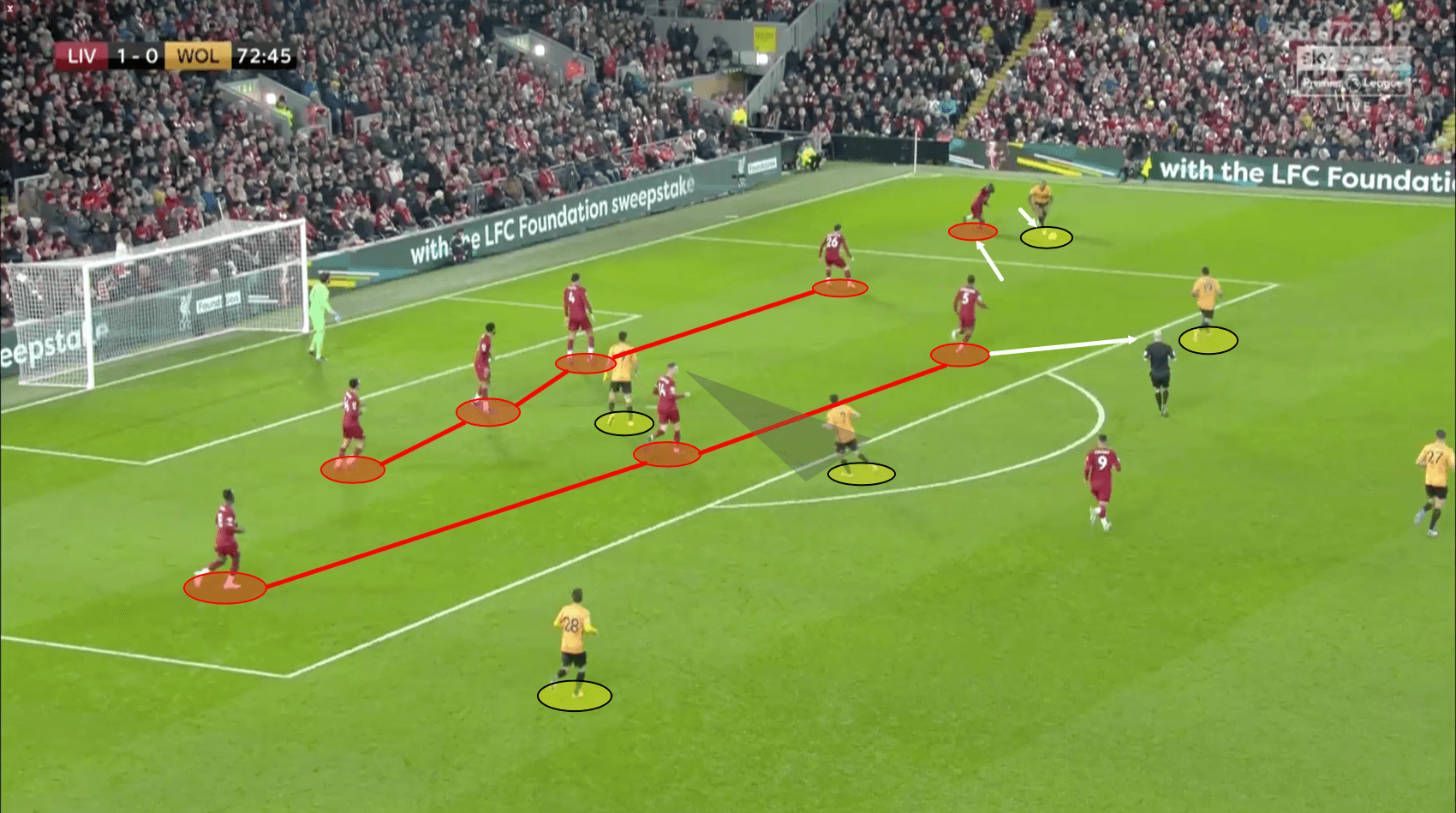
Above, Traoré possesses the ball on the far side of Liverpool’s box. Instead of Robertson moving out to apply pressure, Mané performs the action instead. Even though Traoré is able to dribble past Mané, his defensive effort allows Robertson to uphold Liverpool’s compact back four. Wijnaldum presses the nearest passing option, Henderson watches the central option at the top of the box, and Traoré is forced into a cross, which sails well past the end line for a Liverpool goal kick.
Conclusion
With an xG of 1.51 to 0.46, Liverpool no doubt had the upper hand throughout the match. The defensive structures from both sides limited chances, but Klopp’s attacking devices eventually combated and out-manoeuvered Nuno’s defensive strategies. It cannot be stated enough how perfectly Liverpool’s players fit into the manager’s tactics, and the Merseyside club looks primed to resume their pursuit for a Premier League title through the second half of the season.
Wolves sit seventh on the table as a result. Despite the loss, the West Midlands club under Nuno will continue to be a defensive stalwart against a majority of the league, and will be looking forward to their first European knockout round in over 45 years as they face La Liga side Espanyol in the Europa League round of 32 in March.

If you love tactical analysis, then you’ll love the digital magazines from totalfootballanalysis.com – a guaranteed 100+ pages of pure tactical analysis covering topics from the Premier League, Serie A, La Liga, Bundesliga and many, many more. Buy your copy of the December issue for just ₤4.99 here





Comments